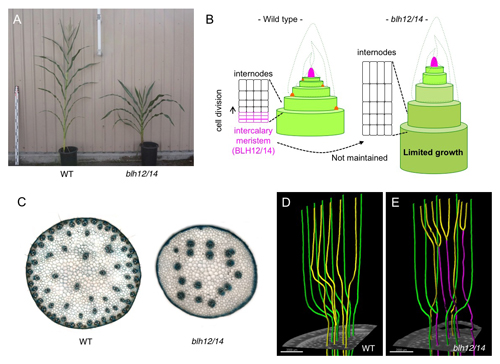Regulation of internode patterning and vein anastomosis in maize stems.
Experimental Farm / Nonomura Group
Mammalian Genetics Laboratory / Shiroishi Group
KNOTTED1 Cofactors, BLH12 and BLH14, Regulate Internode Patterning and Vein Anastomosis in Maize
Katsutoshi Tsuda, Maria-Jazmin Abraham-Juarez, Akiteru Maeno, Zhaobin Dong, Dale Aromdee, Robert Meeley, Toshihiko Shiroishi, Ken-ichi Nonomura and Sarah Hake.
The Plant Cell. published online April 5, 2017 DOI:10.1105/tpc.16.00967
Monocot stems lack the vascular cambium and instead have characteristic structures in which intercalary meristems generate internodes and veins remain separate and scattered. Developmental processes of these unique structures, however, have been poorly described. We found that maize BELL1-like homeodomain transcription factors, BLH12 and BLH14, have redundant but important roles in stem development. BLH12/14 interact with the shoot meristem regulator, KNOTTED1 (KN1) in vivo, and accumulate in overlapping domains in shoot meristems, young stems and provascular bundles. In addition to defects in the maintenance and development of various shoot meristems, blh12/14 double mutant showed unique abnormalities in the stem including shortened internodes and the reduced vein number. Detailed observation of BLH12/14 accumulation patterns and of stem inner structures using micro-computed tomography (CT) suggested that BLH12/14 (1) maintain intercalary meristems at the bottom of internodes to provide internodal cells as differentiated progenies, and (2) prevent precocious anastomosis of provascular bundles in young stems to ensure the production of sufficient independent veins. This work is the collaborative work between Katsutoshi Tsuda in Experimental Farm and Prof. Sarah Hake in University of California, Berkeley, and was supported by JSPS KAKENHI JP16K18637. Micro-CT scanning performed by Akiteru Maeno in Mammalian Genetics Lab enabled to capture the detailed view of inner stem structures and vein networks.

- (A) Wild-type (left) and blh12/14 (right) plants. blh12/14 double mutants show a dwarf phenotype.
- (B) Intercalary meristems are maintained by BLH12/14. In blh12/14, intercalary meristems were differentiated into internode and lost, leading to limited growth and dwarfness.
- (C) Transverse sections of wild-type (left) and blh12/14 double mutant (right) stems. blh12/14 had much fewer veins compared to wild type.
- (D) A vein network in the wild type stem extracted from micro CT data. Veins do not anastomose each other.
- (E) A vein network in the blh12/14 double mutant stem. Precociously anastomosed veins (magenta) were frequently observed.















